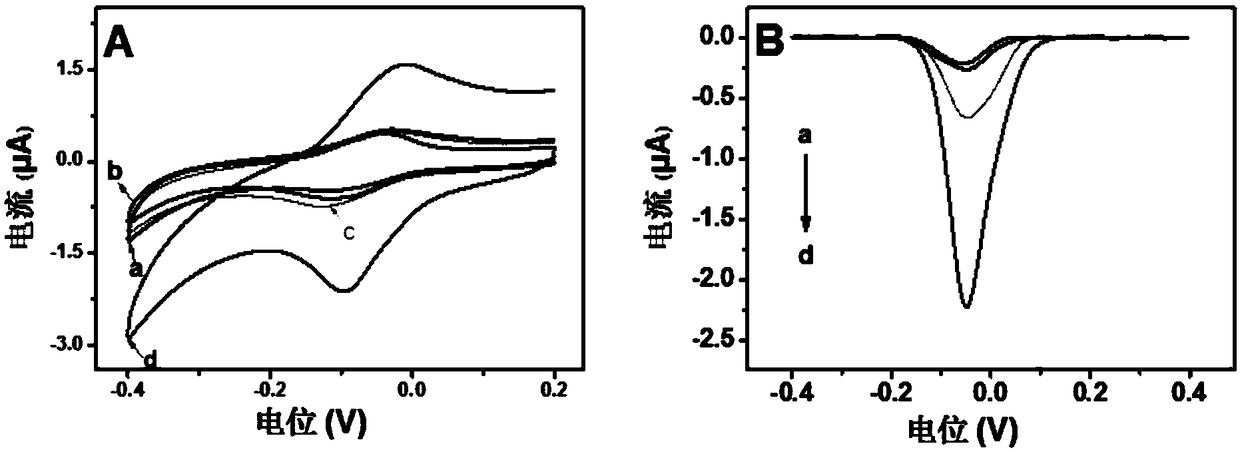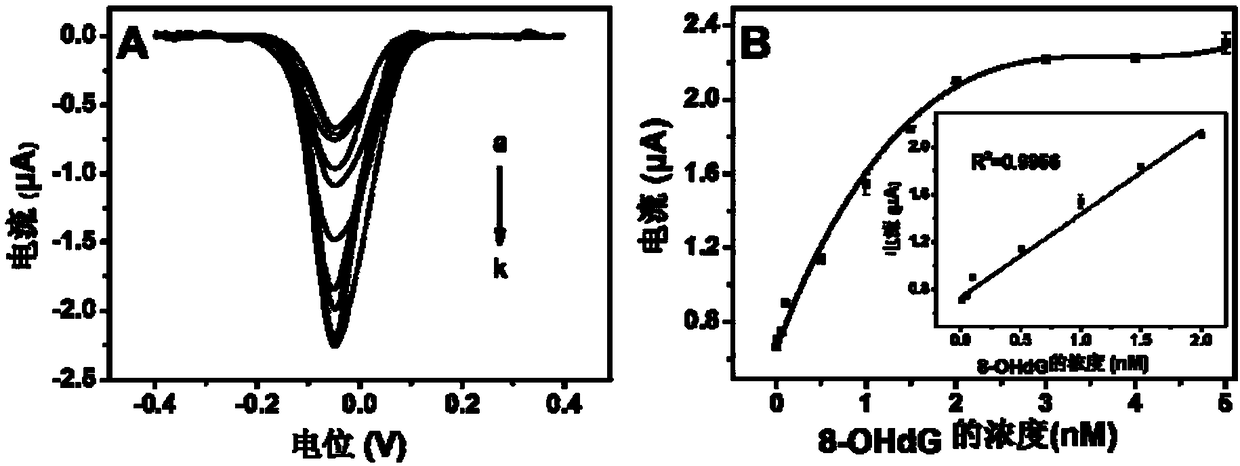A Method for Quantitative Detection of 8-OHDG Activity Based on Aniline Deposition Electrochemical Sensing Electrode
A sensing electrode and quantitative detection technology, applied in the field of biosensing, can solve the problem that the detected value is higher than the real value, and achieve the effects of good environmental stability, high-efficiency enzyme catalytic activity, and high sensitivity
- Summary
- Abstract
- Description
- Claims
- Application Information
AI Technical Summary
Problems solved by technology
Method used
Image
Examples
Embodiment 1
[0041] The electrochemical sensing electrode based on polyaniline deposition quantitatively detects the activity of 8-hydroxydeoxyguanosine, and the detection steps are:
[0042] 1) Mix 0.5 μL each of the three single strands A, B, and C with sulfhydryl groups modified at the 5’ end and D chain with 8-hydroxydeoxyguanosine aptamer at the 5’ end in 40 μL TM buffer and 0.5 μL TCEP in equal proportions In the method, prepare a sample with a final concentration of 0.5 μM, then put the prepared sample in a 90°C hot water bath for 10 minutes, then quickly cool down to 1°C, and keep it in 1°C for more than 40 minutes, you can get the DNA tetrahedral structure with sulfhydryl groups;
[0043] 2) The modification of the DNA tetrahedral structure with the sulfhydryl group connected to the 8-OHdG aptamer on the gold electrode to obtain the electrode with the DNA tetrahedral structure connected to the 8-OHdG aptamer at the top: first soak the gold electrode in piranha Lotion (H 2 o 2 a...
Embodiment 2
[0047] Embodiment 2: The electrochemical sensing electrode based on polyaniline deposition quantitatively detects the activity of 8-hydroxydeoxyguanosine, and the detection steps are:
[0048] 1) Mix 2 μL each of the three single strands A, B, and C with sulfhydryl groups modified at the 5’ end and D strand with 8-hydroxydeoxyguanosine aptamer at the 5’ end in 50 μL TM buffer and 2 μL TCEP in equal proportions, Prepare a sample with a final concentration of 2 μM, then place the prepared sample in a hot water bath at 100°C for 3 minutes, then quickly cool down to 5°C, and keep at 5°C for more than 20 minutes to obtain the thiol-containing DNA tetrahedral structure; the TM buffer solution is 20mM Tris-HCl solution containing pH=8.0 and 50mM MgCl 2 solution, CH 3 COOH-CH 3 COONa buffer solution containing 100mM CH 3 COOH and 100mM CH 3 The buffer solution of pH=4.3 of COONa;
[0049] 2) The modification of the DNA tetrahedral structure with the sulfhydryl group connected to ...
Embodiment 3
[0054] The electrochemical sensing electrode based on polyaniline deposition quantitatively detects the activity of 8-hydroxydeoxyguanosine, and the detection steps are:
[0055] 1) Mix 1.25 μL each of the three single chains A, B, and C with sulfhydryl groups modified at the 5’ end and D chain with 8-hydroxydeoxyguanosine aptamer at the 5’ end in 45 μL TM buffer and 1.25 μL TCEP in equal proportions In the method, prepare a sample with a final concentration of 1.25 μM, then place the prepared sample in a 95°C hot water bath for 6 minutes, then quickly cool down to 3°C, and keep it in 3°C for more than 30 minutes, and you can get the DNA tetrahedral structure with sulfhydryl groups;
[0056] 2) The modification of the DNA tetrahedral structure with the sulfhydryl group connected to the 8-OHdG aptamer on the gold electrode to obtain the electrode with the DNA tetrahedral structure connected to the 8-OHdG aptamer at the top: first soak the gold electrode in piranha Lotion (H 2...
PUM
 Login to View More
Login to View More Abstract
Description
Claims
Application Information
 Login to View More
Login to View More - R&D
- Intellectual Property
- Life Sciences
- Materials
- Tech Scout
- Unparalleled Data Quality
- Higher Quality Content
- 60% Fewer Hallucinations
Browse by: Latest US Patents, China's latest patents, Technical Efficacy Thesaurus, Application Domain, Technology Topic, Popular Technical Reports.
© 2025 PatSnap. All rights reserved.Legal|Privacy policy|Modern Slavery Act Transparency Statement|Sitemap|About US| Contact US: help@patsnap.com



